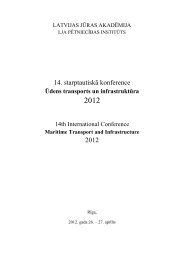You also want an ePaper? Increase the reach of your titles
YUMPU automatically turns print PDFs into web optimized ePapers that Google loves.
ASSESSMENT OF CONTRIBUTION OF MARITIME EDUCATIONINSTITUTIONS IN LATVIAN SEAFARERS POOLRoberts Gailītis<strong>Latvian</strong> <strong>Maritime</strong> Administration, 5 Trijādības Street, Riga, LV-1048, LatviaE-mail: roberts.gailitis@lja.lvAbstractLatvia has become a seafarers’ supply country for others by lacking own shipowners. Only about 4% ofmerchant fleet seafarers are employed under <strong>Latvian</strong> flag. However, seafarers’ resource is important for<strong>Latvian</strong> economy as the employment of seafarers contributes to <strong>Latvian</strong> economy by money brought fromabroad and spent here. <strong>Maritime</strong> education institutions plays important role at inflow processes ofseafarers’ pool, which are involved in training of future ships’ officers as the demand for merchant fleetofficers is growing in industry. Assessment of the contribution made by maritime education institution isdone by comparing statistical information about the graduates from different institutions to have clearview on future of <strong>Latvian</strong> seafarers’ resource and the sustainability of present conditions. This approachprovides objective and sound basis for conclusions about the contribution made by different maritimeeducation institutions. Therefore the aim of this article is to show the methods and results of contributionanalysis made by Seamen Registry of <strong>Latvian</strong> <strong>Maritime</strong> Administration.Keywords: shortage of seafarers, maritime education, seafarers’ poolIntroductionShortage of ship’s officers is one of the main topics discussed in the maritime society. In 2008International <strong>Maritime</strong> Organization (IMO) launched campaign “Go to Sea” [1] with aim to attract newentrants to the shipping industry. The worldwide supply of seafarers in 2010 was estimated to be 624,000officers and 747,000 ratings while the current estimate of worldwide demand for seafarers (in 2010) is637,000 officers and 747,000 ratings [2]. According to BIMCO (Baltic and International <strong>Maritime</strong>Council) the supply data is based on the number of seafarers holding STCW certificates. BIMCO statesthat while demand for ratings is more or less balanced in the same time there are still some shortages forofficers. IMO places emphasis that the global pool of competent and efficient seafarers is prerequisite tomeet future demand which will give possibility to present seafaring to younger generations as a viablecareer choice. While the term “shortage” is widely used it is important to understand that the differencebetween demand and supply figures is calculated by comparing results of two different approaches. Thedemand figures are calculated mainly by modelling the world’s ship stock in terms of ship type, sizerange, vintage and registry in order to calculate the number of officers and ratings that are required forsafe operation of these vessels. The supply figures are estimates and based on information provided bydifferent sources such as questionnaires, data from administrations, education institutions and others [3].Organizations apply various methods therefore it is common to see different figures provided fromdifferent sources. In reality, the amount of details recorded varies therefore the precise figures are difficultto achieve. The main reasons are the globalised nature of the shipping industry and its flexibility,including temporary employment which has become increasingly common [4]. Task Force on maritimeemployment and competitiveness of European Commission states that it is clear that detailed data onmaritime employment is scarce, sometimes out-dated and often not reliable [5]. In their report aboutemployment of EU seafarers they tried to collect available information from various sources to havepicture on the EU seafarers.The shortage of seafarers for EU maritime sectors has additional scope as the seafarers andespecially merchant marine officers’ play recognised role not only for shipping sector but also for othermaritime sectors (marine services, shipbuilding, port services etc.) where they experience and skills areviewed as sustainable input factor for the development of those industries. This view is supported inK. Mitroussi analysis about challenges and opportunities for seafarers’ employment [6]. Thereforedetailed information about maritime education system and its capability to contribute to seafarers’ poolsplays important role for maritime policy decisions at various levels.4
















